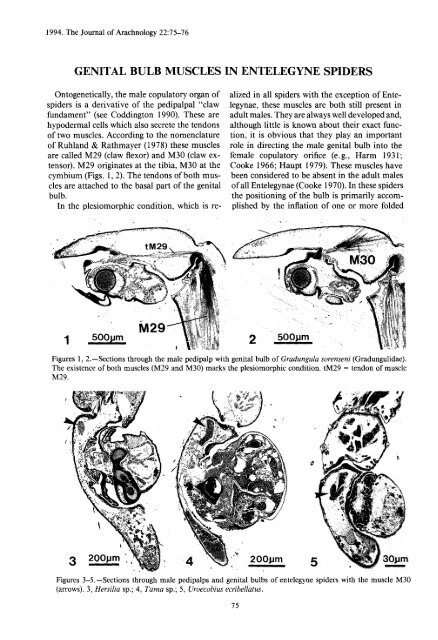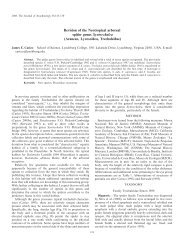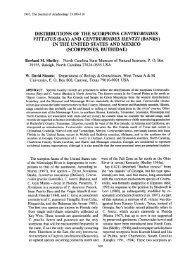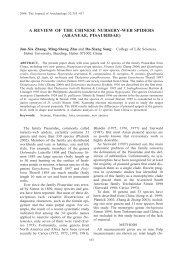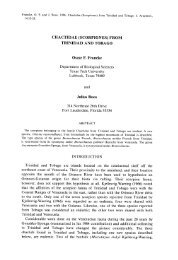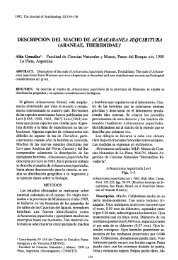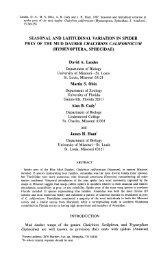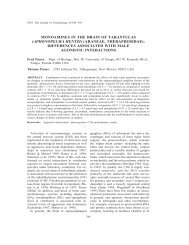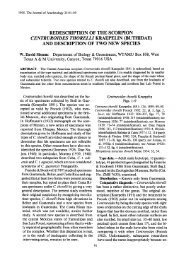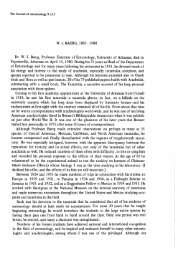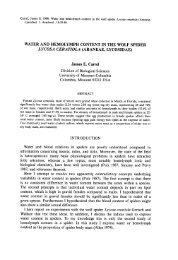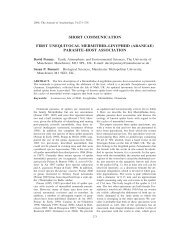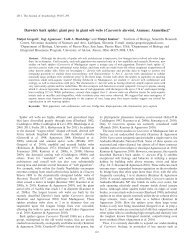genital bulb muscles in entelegyne spider s - American ...
genital bulb muscles in entelegyne spider s - American ...
genital bulb muscles in entelegyne spider s - American ...
Create successful ePaper yourself
Turn your PDF publications into a flip-book with our unique Google optimized e-Paper software.
1994 . The Journal of Arachnology 22 :75—7 6<br />
GENITAL BULB MUSCLES IN ENTELEGYNE SPIDER S<br />
Ontogenetically, the male copulatory organ of<br />
<strong>spider</strong>s is a derivative of the pedipalpal "cla w<br />
fundament" (see Codd<strong>in</strong>gton 1990). These are<br />
hypodermal cells which also secrete the tendon s<br />
of two <strong>muscles</strong> . Accord<strong>in</strong>g to the nomenclature<br />
of Ruhland & Rathmayer (1978) these muscle s<br />
are called M29 (claw flexor) and M30 (claw ex -<br />
tensor). M29 orig<strong>in</strong>ates at the tibia, M30 at th e<br />
cymbium (Figs . 1, 2). The tendons of both <strong>muscles</strong><br />
are attached to the basal part of the <strong>genital</strong><br />
<strong>bulb</strong> .<br />
In the plesiomorphic condition, which is re -<br />
alized <strong>in</strong> all <strong>spider</strong>s with the exception of Entelegynae,<br />
these <strong>muscles</strong> are both still present i n<br />
adult males. They are always well developed and ,<br />
although little is known about their exact function,<br />
it is obvious that they play an important<br />
role <strong>in</strong> direct<strong>in</strong>g the male <strong>genital</strong> <strong>bulb</strong> <strong>in</strong>to th e<br />
female copulatory orifice (e .g., Harm 1931 ;<br />
Cooke 1966 ; Haupt 1979). These <strong>muscles</strong> have<br />
been considered to be absent <strong>in</strong> the adult male s<br />
of all Entelegynae (Cooke 1970). In these <strong>spider</strong>s<br />
the position<strong>in</strong>g of the <strong>bulb</strong> is primarily accomplished<br />
by the <strong>in</strong>flation of one or more folded<br />
Figures 1, 2 .—Sections through the male pedipalp with <strong>genital</strong> <strong>bulb</strong> of Gradungula sorenseni (Gradungulidae) .<br />
The existence of both <strong>muscles</strong> (M29 and M30) marks the plesiomorphic condition . tM29 = tendon of muscle<br />
M29 .<br />
Figures 3—5 .—Sections through male pedipalps and <strong>genital</strong> <strong>bulb</strong>s of <strong>entelegyne</strong> <strong>spider</strong>s with the muscle M3 0<br />
(arrows) . 3, Hersilia sp . ; 4, Tama sp . ; 5, Uroecobius ecribellatus.<br />
75
76 THE JOURNAL OF ARACHNOLOGY<br />
M29 M30<br />
Liphistiidae x x<br />
Mygalomorphae x x<br />
Palaeocribeltatae x x<br />
Austrochiloidea x x<br />
Haplogynae x x<br />
Eresidae<br />
Hersiliidae<br />
Ent . Oecobi<strong>in</strong>ae + Urocte<strong>in</strong>a e<br />
Uroecobiu s<br />
other "lower <strong>entelegyne</strong>s "<br />
higher <strong>entelegyne</strong> s<br />
Figure 6 . —Systematic distribution of <strong>genital</strong> <strong>bulb</strong> mus -<br />
cles <strong>in</strong> <strong>spider</strong>s . The pylogenetic tree is derived fro m<br />
Codd<strong>in</strong>gton & Levi (1991) and Kullmann & Zimmer -<br />
mann (1976) . Ent. = Entelegynae .<br />
membranes, the hematodochae (e. g., Osterloh<br />
1922; van Helsd<strong>in</strong>gen 1965 ; Grasshoff 1968) .<br />
A broad comparative <strong>in</strong>vestigation of the anatomy<br />
of <strong>spider</strong> <strong>genital</strong>ia revealed that the systematic<br />
distribution of the muscle M30 is not that<br />
simple. The <strong>bulb</strong>s from representatives of mor e<br />
than 50 families (35 <strong>entelegyne</strong> families) were<br />
embedded <strong>in</strong> ERL-4206 epoxy res<strong>in</strong> and histological<br />
serial sections (1µm) were prepared . In al l<br />
<strong>entelegyne</strong> species exam<strong>in</strong>ed, the muscle M29 i s<br />
absent . In three of these species, the muscle M30 ,<br />
however, is present (Figs . 3—5) : Hersilia sp. <strong>in</strong>det<br />
., Tama sp. <strong>in</strong>det. (both: Hersiliidae) and<br />
Uroecobius ecribellatus (Oecobiidae) . The closest<br />
relatives (accord<strong>in</strong>g to Codd<strong>in</strong>gton & Levi 1991 )<br />
(Fig. 6) of these three species that were exam<strong>in</strong>ed<br />
are : Oecobius cellariorum, Uroctea durandi (both :<br />
Oecobiidae) and Eresus niger (Eresidae). They<br />
all lack both <strong>muscles</strong> . This is also true of the<br />
other "lower <strong>entelegyne</strong>s" (sensu Codd<strong>in</strong>gton &<br />
Levi 1991) that were exam<strong>in</strong>ed (representative s<br />
of Nicodamidae, Zodariidae, Miturgidae, Homalonychidae).<br />
These results are surpris<strong>in</strong>g from a phylogenetic<br />
po<strong>in</strong>t of view . If we assume the existence<br />
of M30 <strong>in</strong> the steml<strong>in</strong>e of Entelegynae we face<br />
its <strong>in</strong>dependent loss at least three times (accord<strong>in</strong>g<br />
to the phylogenetic tree of Codd<strong>in</strong>gton &<br />
Levi) (Fig . 6): <strong>in</strong> (1) Eresidae, (2) Oecobiidae +<br />
Urocte<strong>in</strong>ae and <strong>in</strong> (3) other "lower <strong>entelegyne</strong>s"<br />
+ higher <strong>entelegyne</strong>s. The distribution of th e<br />
muscle M30 may provide evidence that Eresidae<br />
is closer to other <strong>entelegyne</strong>s than to Oecobiidae<br />
+ Hersiliidae, <strong>in</strong> which case only two steps are<br />
needed .<br />
I am very thankful to all those persons wh o<br />
generously sacrificed valuable material for serial<br />
section<strong>in</strong>g : A. Dippenaar and M . R. Filmer (South<br />
Africa), R . R. Forster (New Zealand), F . Gasparo<br />
(Italy), C. E. Griswold (USA), R. J. Raven (Australia),<br />
G . Schmidt (Germany), P. Schwend<strong>in</strong>ge r<br />
(Austria). I thank N. Platnick for valuable suggestions<br />
on a previous manuscript .<br />
LITERATURE CITED<br />
Codd<strong>in</strong>gton, J . A. 1990. Ontogeny and homology <strong>in</strong><br />
the male palpus of orb-weav<strong>in</strong>g <strong>spider</strong>s and thei r<br />
relatives, with comments on phylogeny (Araneocla -<br />
da: Araneoidea, De<strong>in</strong>opoidea). Smithsonian Contrib.<br />
Zool., 496 :1-52 .<br />
Codd<strong>in</strong>gton, J . A. & H . W. Levi. 1991 . Systematics<br />
and evolution of <strong>spider</strong>s (Araneae) . Annu . Rev . Ecol .<br />
Syst ., 22 :565-592 .<br />
Cooke, J . A. L. 1966. Synopsis of the structure and<br />
function <strong>in</strong> the <strong>genital</strong>ia of Dysdera crocata (Araneae,<br />
Dysderidae) . Senck. Biol., 47(1) :35-43 .<br />
Cooke, J . A . L. 1970 . Spider <strong>genital</strong>ia and phylogeny .<br />
Bull . Mus. Nat. Hist. Natur, 2e ser., 41, suppl. 1 :142-<br />
146 .<br />
Grasshoff, M . 1968 . Morphologische Kriterien als<br />
Ausdruck von Artgrenzen bei Radnetzsp<strong>in</strong>nen de r<br />
Subfamilie A.rane<strong>in</strong>ae (Arachnida: Araneae : Araneidae)<br />
. Abh. senckenberg . naturforsch. Ges., 516 :<br />
1-100 .<br />
Harm, M. 1931. Beitrage zur Kenntnis des Baues ,<br />
der Funktion and der Entwicklung des akzessorischen<br />
Kopulationsorgans von Segestria bavarica C.<br />
L. Koch . Z. Morph. Okol . Tiere, 22:629-670 .<br />
Haupt, J. 1979. Lebensweise and Sexualverhalten der<br />
mesothelen Sp<strong>in</strong>ne Heptathela nishihirai n. sp .<br />
(Araneae, Liphistiidae) . Zool . Anz., 202 :348-374 .<br />
Kullmann, E. & W . Zimmermann . 1976. E<strong>in</strong> neue r<br />
Beitrag zum Cribellaten-Ecribellaten-Problem : Beschreibung<br />
von Uroecobius ecribellatus n. gen. n . sp.<br />
and Diskussion se<strong>in</strong>er phylogenetischen Stellung<br />
(Arachnida : Araneae : Oecobiidae) . Ent . Germanica ,<br />
3(1/2):29-40.<br />
Osterloh, A . 1922. Beitrage zur Kenntnis des Kopulationsapparates<br />
e<strong>in</strong>iger Sp<strong>in</strong>nen . Z . w<strong>in</strong>s . Zool . ,<br />
119:326-421 .<br />
Ruhland, M . & W. Rathmayer. 1978 . Die Be<strong>in</strong>muskulatur<br />
and irhe Innervation bei der Vogelsp<strong>in</strong>ne<br />
Dugesiella hentzi (Ch .) (Araneae, Aviculariidae) .<br />
Zoomorphologie, 89:33-46.<br />
van Helsd<strong>in</strong>gen, P . J. 1965 . Sexual behaviour of Lepthyphantes<br />
leprosus (Ohlert) (Araneida, L<strong>in</strong>yphiidae),<br />
with notes on the function of the <strong>genital</strong> organs<br />
. Zool. Mededel., 41(2) :15-42 .<br />
Bernhard A . Huber : Institut Mr Zoologie de r<br />
Universitat Wien; Althanstr. 14, A-1090 Wien,<br />
Austria.<br />
Manuscript received 29 June 1993, revised 10 September<br />
1993 .


